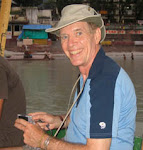If you have never been to my apartment, imagine an open loft space with high ceilings, skylights, large windows with views of Manhattan, and a working fireplace. As is often the case, the fireplace commands a position of attention. Understandably, it is over the fireplace that I have hung perhaps my most prized photograph.
One by Nancy Burston is actually a composite of three photographs. I first saw it when I went to a gallery to see another photographer’s exhibit. While this photograph held my attention for only a few minutes, it remained with me. It spoke to me, and kept calling me back; I was constantly seeing it in my mind’s eye. The photograph is a composite of portraits of people who are likenesses of the commonly accepted perceptions of Jesus, Buddha, and Muhammad. It is in shades of orange. As the light changes, as you move from one place in the room to another, as you stand up or sit down, the image that you see changes. The Gods of worldly religions as One. They are ever-present—in my living room, and in my life.
The theme of one first entered my consciousness during a Yoga for Transformation workshop that began in the fall of 2006 and continued into the winter. One of the outcomes of the workshop was the development of a personal mission statement. This was mine.
T"o see the world in a grain of sand, in this moment, each moment. Every day seeking in that vision greater clarity and acceptance. And, sharing my sight with all whom I touch – with warmth, joy, and goodness of intent. " (From William Blake’s “Auguries of Innocence, “ To see a World in a Grain of Sand, And a Heaven in a Wild Flower. Hold Infinity in the palm of your hand And Eternity in an hour.)
Others have echoed this theme. One of the most eloquent of these was Black Elk. The first peace, which is the most important, is that which comes from within the souls of men when they realize their relationship, their oneness, with the universe and all its powers, and when they realize that at the center of the universe dwells Wakan-Tanka, and that this center is really everywhere, it is within each of us. This is the real peace, and the others are but reflections of this. The second peace is that which is made between two individuals, and the third is that which is made between two nations. But above all you should understand that there can never be peace between nations until there is first known that true peace which is within the souls of men. Wakan-Tanka is the term for the "sacred" or the "divine" as understood by the Lakota people.
One instructs me to look for that sacredness, that divine, within each of us. That I live this moment, each moment, striving toward one is my daily commitment.
Subscribe to:
Post Comments (Atom)

No comments:
Post a Comment